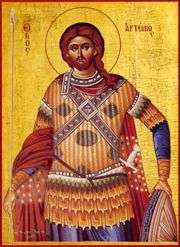Artemius
| Artemius of Antioch | |
|---|---|
|
Icon of the Martyr Artemius | |
| Megalomartyr ("Great Martyr"), Shallita | |
| Born | unknown |
| Died |
362[1] Antioch (relics transferred to Constantinople) |
| Canonized | pre-congregation |
| Feast | 20 October |
| Patronage | hernias |
Artemius (d. in Antioch, 362), known as Challita in the Maronite tradition, was a general of the Roman Empire, dux Aegypti (imperial prefect of Roman Egypt). He is considered a saint by the Orthodox Church, with the name of Artemius of Antioch.
Biography
Artemius was an Egyptian by birth and a chief commander under Emperor Constantine the Great.[2] Constantius II ordered Artemius to go in the lands beyond the Danube and to bring back to Constantinople the relics of Andrew the Apostle, Luke the Evangelist and Saint Timothy. Artemius accomplished his task and was rewarded with the appointment to the rank of dux Aegypti (360).[3]
One year later Constantius was succeeded by his cousin Julian, who was a Pagan. The people of Alexandria accused Artemius of having demolished their temples, and broken down their idols,[1] and Julian condemned him to death. Artemius was beheaded in 362 in the city of Antioch, where he had been recalled by Emperor Julian the Apostate for maladministration of his province.[4] The charges stemmed from his persecution of pagans in Alexandria, and his use of troops in the seizure and despoliation of the Temple of Serapis instigated by George of Cappadocia. According to Ammianus Marcellinus, his death encouraged the people of Alexandria to kill George,[5] but this information is probably false, because George was already dead before his trial.
Hagiography
He is recognized as a saint for his martyrdom; his feast day was set as 20 October.[6] His cult site was as the Church of Saint John the Forerunning (St John the Baptist) in Constantinople.[7] St Artemius is invoked by those suffering from hernias.[8]
References
- 1 2 Butler, Alban. The Lives of the Saints, Vol.X, 1866
- ↑ "The Holy Great Martyr Artemius, Ecumenical Patriarchate of the orthodox Metropolitanate of Hong Kong and South East Asia
- ↑ Passio Artemii, 16—18.
- ↑ Gibbon, Edward. The Decline and Fall of the Roman Empire. Vol. 2. ElecBook: 1999. p. 319.
- ↑ Ammianus Marcellinus, XXII 11.2-3,8.
- ↑ Lieu, Samuel N. Constantine to Julian: A Source History. Routledge: 1996. pp. 212-215
- ↑ Crisafulli, Virgil & Nesbitt, John, The Miracles of St. Artemios: a collection of miracle stories by an annonymous author of the seventh-century Byzantium (Brill: New York, 1997).
- ↑ "Greatmartyr Artemius at Antioch", Orthodox Church in America
External links
- October 20 in the Synaxarion.
